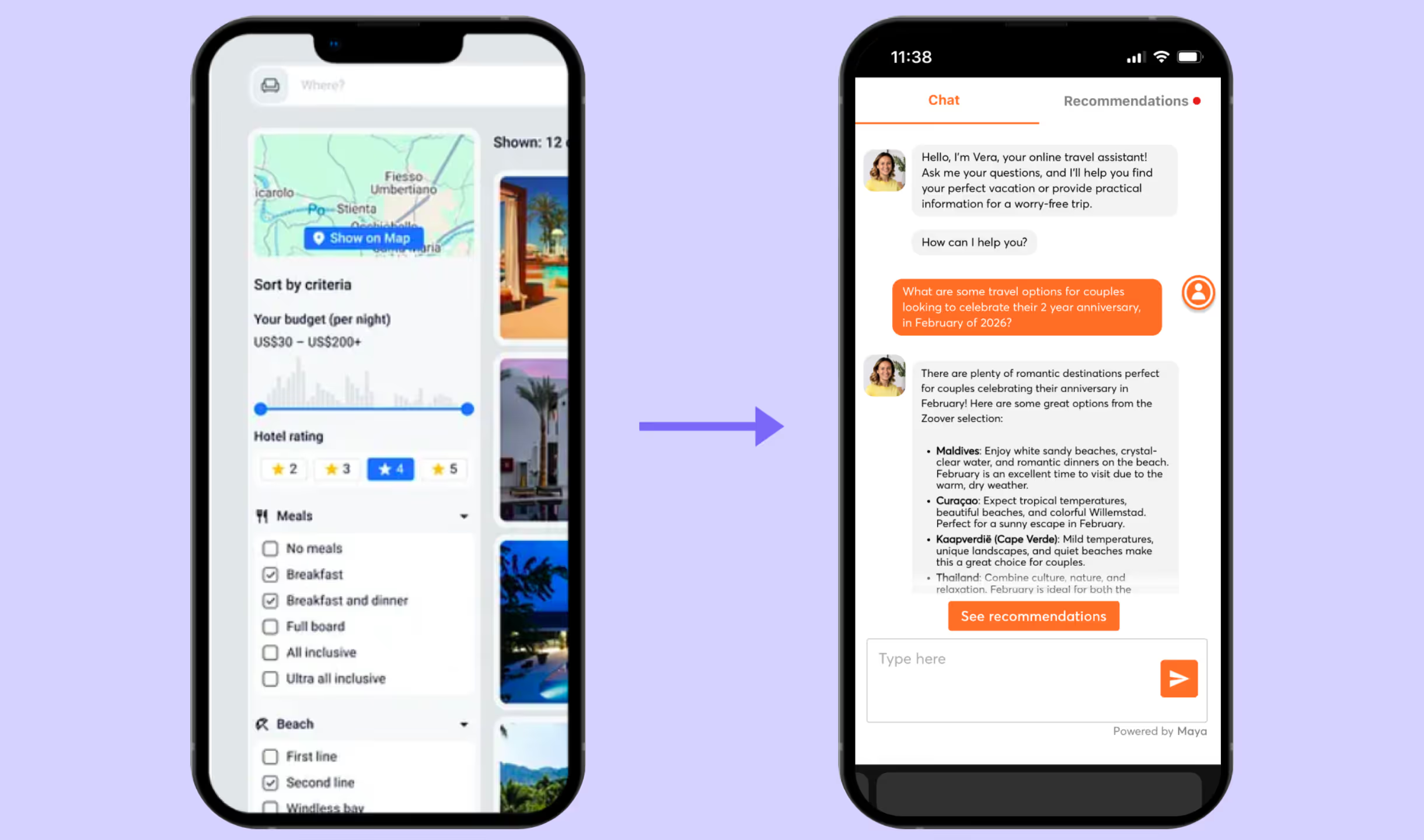Site Abandoment: Decoding Traveler Drop-Offs to Boost Bookings
Most travelers visit your site and leave without booking, but this "lost" traffic is a goldmine of information. By analyzing their searches, chats, and browsing behavior, you can uncover what they're looking for, identify gaps in your offerings, and pinpoint why they leave. This blog explains how to turn these missed opportunities into actionable insights, using visitor abandonment as a roadmap to improve your platform, meet hidden demand, and ultimately drive more bookings.

Table of content
The silent majority: why so many travelers leave without booking
Every day, thousands of travelers visit your website. They scroll. They click. They search. Some even chat online and then—silence. They leave without booking.
It feels like chasing shadows, doesn’t it? You invest heavily to bring travelers in, yet most slip away without leaving a trace, or so it seems.
According to recent statistics, over 70% of travelers use the internet to research and book their trips, making your website your most important marketing tool (Champ Digital, 2025).
But here’s the truth: those “lost” visitors are actually telling you something—loudly. A hint about what they need, want, or couldn’t find on your site. The problem is, most travel companies aren’t listening.
The missed opportunity: What non-converting visitors say and do on your website
When someone abandons your site without booking, it's easy to write it off as a lost opportunity. But what if you're looking at it all wrong?
Think about it: every unanswered question or abandoned itinerary reveals a gap in your content. Those abandoned searches and half-finished chat conversations aren't failures—they're a goldmine of insights into what travelers actually want but couldn't find on your site.
Imagine someone searches for "pet-friendly villas in Tuscany" and then leaves your site without booking. That's not just another bounce rate statistic. It's a clear signal that you're missing content or inventory that people are actively seeking.
The real opportunity lies in capturing this data systematically. When you understand which destinations sparked interest, which details travelers searched for but couldn't find, and where your offers didn't quite meet their needs, abandonment transforms from a frustration into a roadmap. Instead of marking the end of a customer journey, it becomes the starting point for building a smarter, more responsive travel platform.
Content gaps: Spotting missing or incomplete information
Travelers are remarkably direct about what they're looking for—they type it right into your search bar or ask your chatbot. The problem is that most travel websites aren't set up to capture and act on this information.
When you start tracking these patterns across hundreds or thousands of searches, you're no longer guessing what travelers expect—you're seeing exactly where the gaps are in your offerings.
This kind of data makes the invisible visible. You can identify which types of accommodations, experiences, or destinations generate interest but aren't adequately represented on your site. From there, it becomes a straightforward matter of filling those gaps with relevant content and partnerships.
Take the example of a traveler searching for eco-friendly tours. Maya can detect this search pattern and alert your content or product teams, they can prioritize adding sustainable travel options before the next wave of environmentally conscious travelers arrives—and before they abandon your site for a competitor who already has what they're looking for.
Conversation insights: Mining traveler chats and requests
You should think of every chatbot exchange as a mini focus group. A traveler asking “Can I pay in installments?” isn’t just seeking an answer—they’re revealing a potential booking barrier.
Multiply that by hundreds or thousands of visitors a month, and suddenly, you have a goldmine of recurring pain points: payment flexibility, hidden fees, unclear cancellation policies. These aren’t just details—they’re conversion killers.
With Maya, you don’t just see individual chats. You see patterns. Which questions repeat? Where do visitors get stuck? What are the most common reasons for leaving? With this insight, your marketing and product teams can fix the root problems, improve the customer journey, and reduce abandonment.
Search & browsing tracking: Understanding abandoned journeys
Browsing behavior reveals as much as direct questions. When a visitor lands on your "Family Tours in Thailand" page, then jumps to "Luxury Resorts" before leaving, that sequence tells a story. They're looking for something specific—possibly family-friendly luxury options—but aren't finding it in an accessible way.
By connecting search queries, browsing patterns, and exit points, you move beyond tracking what travelers did to understanding why they left. Maybe the price jump between categories was too steep, or critical information about family amenities in luxury properties was missing. These insights point to concrete improvements rather than guesswork.
Behavior analysis: Detecting where travelers drop off
According to Google, 87% of travelers research their trip online before booking. But along that journey, countless drop-off points appear: confusing pricing, unclear inclusions, missing reassurance about safety or policies.
Mapping those drop-offs used to mean drowning in Google Analytics dashboards, but Maya turns that noise into clarity. Instead of wading through metrics, you can see exactly where travelers hesitate—and what they were seeking when they left.
The AI advantage: Insights in real time
Here’s the breakthrough: Maya shows exactly where travelers drop off, spots missing details that block bookings, and uncovers untapped demand in destinations and markets.
It turns abandoned chats into actionable leads, detects traveler frustration in real time, tracks top trip types and niche destinations, and monitors conversion trends—automatically. No armies of analysts needed.
This helps turn confusion to clarity so that lost traffic can become new bookings.
Conclusion: Turning hidden demand into bookings
The truth is, non-converting visitors aren’t a dead end. They’re the most honest focus group you’ll ever have—if you know how to listen.
Maya helps you listen by turning abandoned searches and browsing behavior into a clear map of traveler demand. And it gives you the power to act on it—improving your offers, boosting engagement, and driving more bookings.
Book a Demo and see how Maya’s proactive AI helps your travel company anticipate customer needs, increase engagement, and drive more bookings.
New mobile apps to keep an eye on
Auctor purus, aliquet risus tincidunt erat nulla sed quam blandit mattis id gravida elementum, amet id libero nibh urna nisi sit sed. Velit enim at purus arcu sed ac. Viverra maecenas id netus euismod phasellus et tempus rutrum tellus nisi, amet porttitor facilisis aenean faucibus eu nec pellentesque id. Volutpat, pellentesque cursus sit at ut a imperdiet duis turpis duis ultrices gravida at aenean amet mattis sed aliquam augue nisl cras suscipit.
- Commodo scelerisque convallis placerat venenatis et enim ullamcorper eros.
- Proin cursus tellus iaculis arcu quam egestas enim volutpat suspendisse
- Sit enim porttitor vehicula consequat urna, eleifend tincidunt vulputate turpis
What new social media mobile apps are available in 2022?
At elit elementum consectetur interdum venenatis et id vestibulum id imperdiet elit urna sed vulputate bibendum aliquam. Tristique lectus tellus amet, mauris lorem venenatis vulputate morbi condimentum felis et lobortis urna amet odio leo tincidunt semper sed bibendum metus, malesuada scelerisque laoreet risus duis.

Use new social media apps as marketing funnels
Ullamcorper pellentesque a ultrices maecenas fermentum neque eget. Habitant cum esat ornare sed. Tristique semper est diam mattis elit. Viverra adipiscing vulputate nibh neque at. Adipiscing tempus id sed arcu accumsan ullamcorper dignissim pulvinar ullamcorper urna, habitasse. Lectus scelerisque euismod risus tristique nullam elementum diam libero sit sed diam rhoncus, accumsan proin amet eu nunc vel turpis eu orci sit fames.
- Eget velit tristique magna convallis orci pellentesque amet non aenean diam
- Duis vitae a cras morbi volutpat et nunc at accumsan ullamcorper enim
- Neque, amet urna lacus tempor, dolor lorem pulvinar quis lacus adipiscing
- Cursus aliquam pharetra amet vehicula elit lectus vivamus orci morbi sollicitudin
“Sit enim porttitor vehicula consequat urna, eleifend tincidunt vulputate turpis, dignissim pulvinar ullamcorper”
Try out Twitter Spaces or Clubhouse on iPhone
Nisi in sem ipsum fermentum massa quisque cursus risus sociis sit massa suspendisse. Neque vulputate sed purus, dui sit diam praesent ullamcorper at in non dignissim iaculis velit nibh eu vitae. Bibendum euismod ipsum euismod urna vestibulum ut ligula. In faucibus egestas dui integer tempor feugiat lorem venenatis sollicitudin quis ultrices cras feugiat iaculis eget.
Try out Twitter Spaces or Clubhouse on iPhone
Id ac imperdiet est eget justo viverra nunc faucibus tempus tempus porttitor commodo sodales sed tellus eu donec enim. Lectus eu viverra ullamcorper ultricies et lacinia nisl ut at aliquet lacus blandit dui arcu at in id amet orci egestas commodo sagittis in. Vel risus magna nibh elementum pellentesque feugiat netus sit donec tellus nunc gravida feugiat nullam dignissim rutrum lacus felis morbi nisi interdum tincidunt. Vestibulum pellentesque cursus magna pulvinar est at quis nisi nam et sed in hac quis vulputate vitae in et sit. Interdum etiam nulla lorem lorem feugiat cursus etiam massa facilisi ut.












.svg)